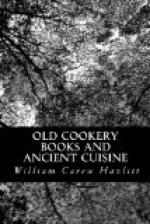There may be an inclination to revolt against the barbarous doggerel in which the instruction is, as a rule, conveyed, and against the tedious process of perusing a series of productions which follow mainly the same lines. But it is to be recollected that these manuals were necessarily renewed in the manuscript form from age to age, with variations and additions, and that the writers resorted to metre as a means of impressing the rules of conduct more forcibly on their pupils.
Of all the works devoted to the management of the table and kitchen, the “Book of Nurture,” by John Russell, usher of the chamber and marshal of the ball to Humphrey, Duke of Gloucester, is perhaps, on the whole, the most elaborate, most trustworthy, and most important. It leaves little connected with the cuisine of a noble establishment of the fifteenth century untouched and unexplained; and although it assumes the metrical form, and in a literary respect is a dreary performance, its value as a guide to almost every branch of the subject is indubitable. It lays bare to our eyes the entire machinery of the household, and we gain a clearer insight from it than from the rest of the group of treatises, not merely into what a great man of those days and his family and retainers ate and drank, and how they used to behave themselves at table, but into the process of making various drinks, the mystery of carving, and the division of duties among the members of the staff. It is, in fact, the earliest comprehensive book in our literature.
The functions of the squire at the table of a prince are, to a certain extent, shown in the “Squire of Low Degree,” where the hero, having arrayed himself in scarlet, with a chaplet on his head and a belt round his waist, cast a horn about his neck, and went to perform his duty in the hall. He approaches the king, dish in hand, and kneels. When he has served his sovereign, he hands the meats to the others. We see a handsome assortment of victuals on this occasion, chiefly venison and birds, and some of the latter were baked in bread, probably a sort of paste. The majority of the names on the list are familiar, but a few—the teal, the curlew, the crane, the stork, and the snipe—appear to be new. It is, in all these cases, almost impossible to be sure how much we owe to the poet’s imagination and how much to his rhythmical poverty. From another passage it is to be inferred that baked venison was a favourite mode of dressing the deer.
The precaution of coming to table with clean hands was inculcated perhaps first as a necessity, when neither forks nor knives were used, and subsequently as a mark of breeding. The knife preceded the spoon, and the fork, which had been introduced into Italy in the eleventh century, and which strikes one as a fortuitous development of the Oriental chopstick, came last. It was not in general use even in the seventeenth century here. Coryat the traveller saw it among the Italians, and deemed it a luxury and a notable fact.




